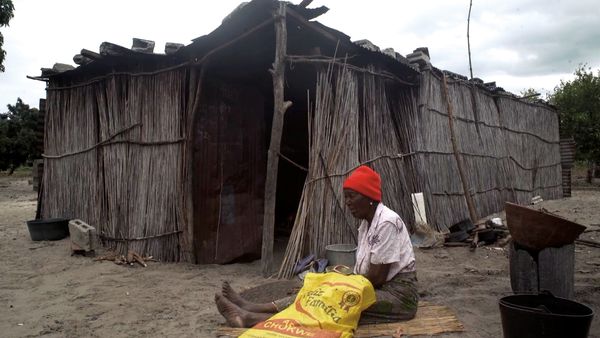Eye For Film >> Movies >> The Nights Still Smell Of Gunpowder (2024) Film Review
The Nights Still Smell Of Gunpowder
Reviewed by: Nikola Jovic

A lot of the time, we talk about forgetting as a form of letting go, but in Inadelso Cossa’s sophomore docu-fiction feature, forgetting is a haunting, undead, presence. In The Nights Still Smell Of Gunpowder, which premiered at the Berlinale, the director presents a haunting exploration of memory against the backdrop of Mozambique's tumultuous civil war that lasted for 15 years. Through sensory imagery and interviews with the villagers, Cossa delves into the lingering echoes of conflict, weaving together personal recollections and archival footage in order to put his mind at rest and resolve repressed traumas from the event.
We open on the archival footage from before the civil war. Bare feet in the sand pushing against something out of frame. Working on the land. Kids playing in the lake, only to match cut to the backs of the heads of dead young men, leading us into wartime. Once we’re in the present day, we’re treated to the wide landscapes of the village. The sounds are calming, the nature peaceful, yet the presence of a boom mic operator, Mises (Moises Langa), not only shows us that something is off, but also that what we’re seeing is constructed. As we’ll soon find out, Cossa has trouble remembering the war, so seeing the peaceful and calming scenery, where unactivated mines might or might not be laying, disturbs him even more. His grandmother, who was old enough to remember the war, suffers from Alzheimer’s - only being able to access her memory during the night. In that sense, at night, both of them are trying, through evocation of sense memory, to revive something long gone and almost lost.
It isn’t surprising then, that when you go out searching in the night for something long gone, that you find something. “It was when I was looking for the sounds in the cemetery… So immersed in it that I heard the answer from the grave,” the narration says, early on in the film, giving off a kind of ominous and haunted feeling to the place which never leaves us. This feeling is even more reinforced through evocative imagery, such as shots of an empty chair at dawn, where Cossa’s late grandfather used to sit, or many images of hands and feet, and of analogue photos laid out in the ground, as if they naturally belonged there. Although he and his grandmother find themselves in a similar predicament, what the director soon realises is that, while he’s trying to bring back the past, old people involved in the violence discovered something he called “closeness brought by a violent past [...] a will to belong to the present”.
Degraded, grainy, sepia footage in contrast with clean digital images in a way presents a similar rift the person experiences if they want to go back to something lost, in that sense, once again, proving the enlightenment adage that the inner world is the reflection of the outer world, and vice versa. By juxtaposing evocative imagery and his outlook with the very real survivors of the conflict and the stories they’re retelling, the director creates more of a musing on time and echoes of violence, rather than a doc about the civil war itself.
Reviewed on: 27 Feb 2024














